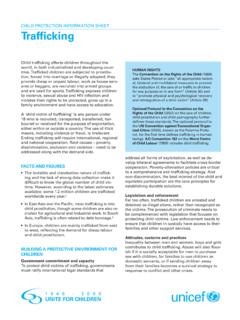Transcription of Model Law against the Illicit Manufacturing of and ...
1 Vienna International Centre, PO Box 500, 1400 Vienna, Austria Tel.: (+43-1) 26060-0, Fax: (+43-1) 26060-5866, *1182761* united nations publicationPrinted in AustriaSales No. 32 ISBN July 2011 220 Model Law against the Illicit Manufacturing of and Trafficking in Firearms, Their Parts and Components and AmmunitionModel Law against the Illicit Manufacturing of and Trafficking in FirearmsUNITED nations office ON DRUGS AND CRIMEM odel Law against the Illicit Manufacturing of and Trafficking in Firearms, Their Parts and Components and AmmunitionUNITED nations Vienna, 2011 NoteSymbols of united nations documents are composed of capital letters combined with figures. Mention of such a symbol indicates a reference to a united nations nations PUBLICATIONS ales No.
2 ISBN 978-92-1-133712-9eISBN 978-92-1-054985-1 united nations , July 2011. All rights designations employed and the presentation of material in this publication do not imply the expression of any opinion whatsoever on the part of the Secretariat of the united nations concerning the legal status of any country, territory, city or area, or of its authorities, or concerning the delimitation of its frontiers or for permission to reproduce this work are welcomed and should be sent to the Secretary of the Publications Board, united nations Headquarters, New York, 10017, or also see the website of the Board: Governments and their institutions may reproduce this work without prior authorization but are requested to mention the source and inform the united nations of such production.
3 English, Publishing and Library Section, united nations office at *The Model Law against the Illicit Manufacturing of and Trafficking in Fire-arms, Their Parts and Components and Ammunition was developed by the united nations office on Drugs and crime (UNODC) in response to the request of the General Assembly to the Secretary-General to promote and assist the efforts of Member States to become party to and implement the united nations Convention against Transnational Organized Crime1 and the Protocols It was developed in particular to assist States in imple-menting a legislative regime consistent with the provisions contained in the Protocol against the Illicit Manufacturing of and Trafficking in Firearms, Their Parts and Components and Ammunition, supplementing the united nations Convention against Transnational Organized Consequently, the Conference of the Parties to the united nations Convention against Transnational Organized crime .
4 In its decision 4/6, adopted at its fourth session, urged States parties to the Firearms Protocol to strengthen their national legislation in a manner consistent with the Protocol, and requested the Secretariat to facilitate, whenever possible, technical assistance to States parties facing difficulties in its implementation; and also requested the Sec-retariat to develop technical assistance tools to assist States parties in the implementation of the Firearms Protocol. The Model Law is also a response to the specific technical assistance needs identified by Member States in the questionnaires/checklist used to gather information and assess the implementation of the Organized crime Convention and the Protocols thereto,4 in which many States indicated the need for Model legislation or guidelines in order to harmonize domestic legislation with the requirements of the Convention and its Protocols.
5 The Model Law will both facilitate and help systematize provision of legislative assistance by the Convention as well as facilitate review and amendment of 1 united nations , Treaty Series, vol. 2225, No. 39574. 2 Ibid., vols. 2237, 2241 and 2326, No. 39574. 3 Ibid., vol. 2326, No. 39574. 4 See the note by the Secretariat on an overview of technical assistance needs identified by States in their responses to the questionnaires/checklist on the implementation of the united nations Convention against Transnational Organized crime and the Protocols thereto (CTOC/ ) and the related report on an overview of technical assistance requests made by States through the questionnaires/checklist on the implementation of the Convention (CTOC/ ).
6 * The present preface is intended as an explanatory note on the genesis, nature and scope of the Model Law against the Illicit Manufacturing of and Trafficking in Firearms, Their Parts and Components and Ammunition; it is not part of the text of the Model legislation and adoption of new legislation by States themselves. It is designed to be adaptable to the needs of each State, whatever its legal tradition and social, economic, cultural and geographical conditions. The Model Law is divided into three parts: Part One (Introductory provisions) contains Model Law text on the introductory provisions and definitions States may choose to include in their domestic legislation. Terms used in the Firearms Protocol are included in the definitions.
7 Additionally, draft definitions are suggested for other terms used in the present Model Law. Part Two (Mandatory provisions) contains Model Law text on all the mandatory provisions of the Firearms Protocol that States are required to ensure are included in their domestic legislation. This includes chap-ters on preventive measures aimed at regulating the Manufacturing , marking, record-keeping and international transfers of firearms, their parts and components and ammunition. The mandatory penal provisions that derive from the preventive measures and the mandatory interna-tional cooperation measures are also included in chapters in this part. Part Three (Non-mandatory provisions) elaborates on provisions in the Firearms Protocol on brokers and brokering activities that States are required to consider for inclusion in their national legislation.
8 It also discusses the provision in the Protocol whereby States may adopt sim-plified procedures for the temporary import, export and transit of fire-arms, their parts and components and ammunition. Annex I (Additional considerations) contains other provisions that States can also consider for inclusion in their national legislation. These provisions are included to assist States in developing comprehensive legislation on various aspects of firearms regulation. These suggestions stem from other international instruments and national Each chapter and Model Law provision includes a commentary that explains the requirements of the Firearms Protocol and indicates the source of the provision within the Protocol.
9 Due regard is also given to the inter- 5 The international legal regime on firearms started to develop in the 1990s, when increasing concern for the proliferation of ( Illicit ) firearms brought the issue of Illicit Manufacturing of and trafficking in firearms onto the international agenda. Since then, several global and regional instruments have been adopted, both legally and non-legally binding in nature. Most of these instruments have either preceded or influenced the adoption of the Firearms Protocol ( the Inter-American Convention against the Illicit Manufacturing of and Trafficking in Firearms, Ammunition, Explosives, and Other Related Materials of 1997) or have been adopted after, building on and further developing the acquis of the Firearms Protocol (see annex II for a detailed list of instruments).
10 Vpretative notes for the travaux pr paratoires of the Protocol,6 the Legislative Guides for the Implementation of the united nations Convention against Transnational Organized crime and the Protocols Thereto,7 as well as the forthcoming UNODC technical guide to the implementation of the Firearms The commentaries to the chapters and individual provisions are an integral part of the Model Law and should be read in conjunction with its provisions. The Model Law is designed primarily to assist States in their imple-mentation of the Firearms Protocol. It is not an exhaustive instrument for firearms control. The Model Law also does not provide suggested language for other legislative (criminal, administrative or regulatory) provisions that may need to be reviewed and adapted as a consequence of the adoption of a firearms law beyond those directly referred to in the present Model Law.
















